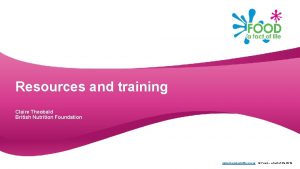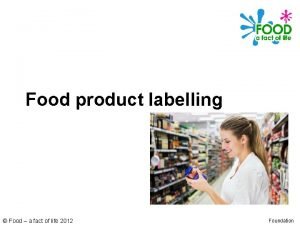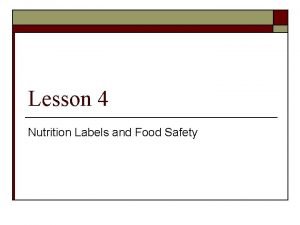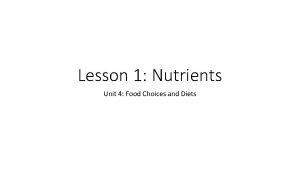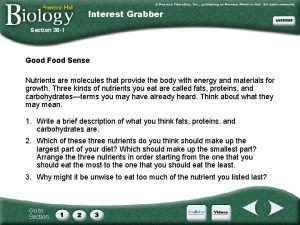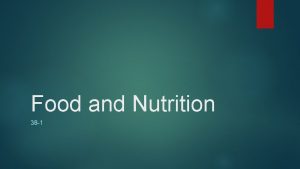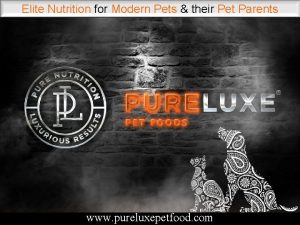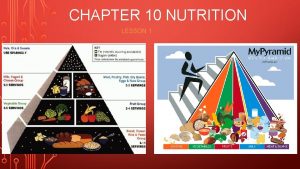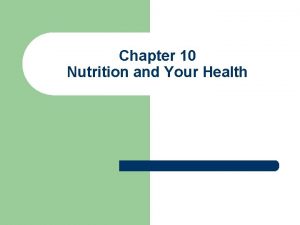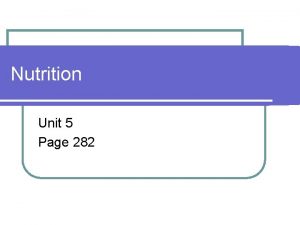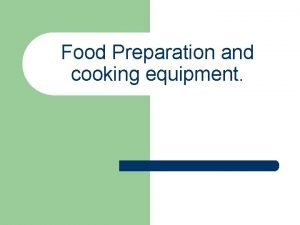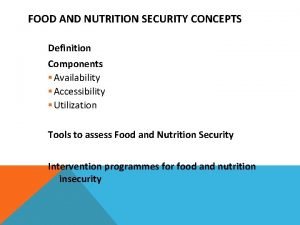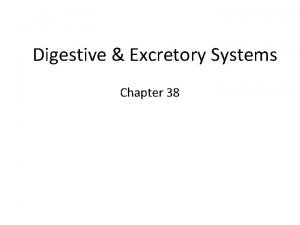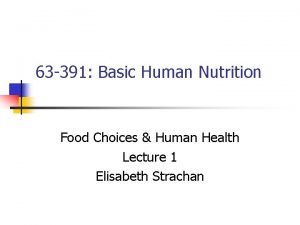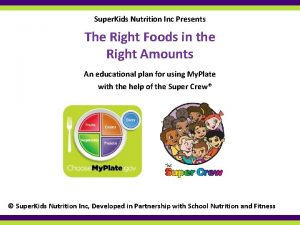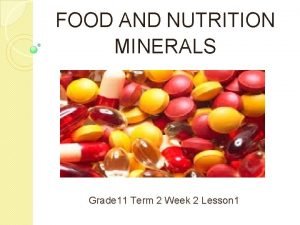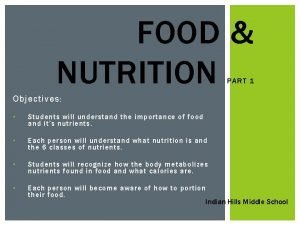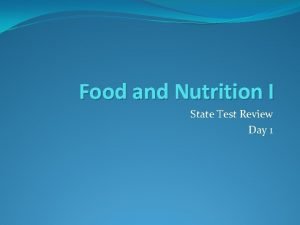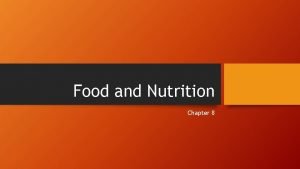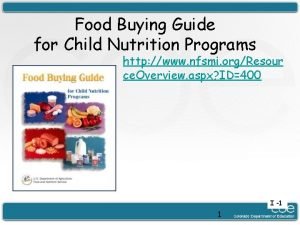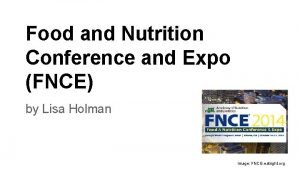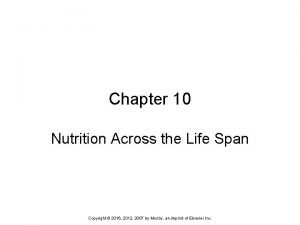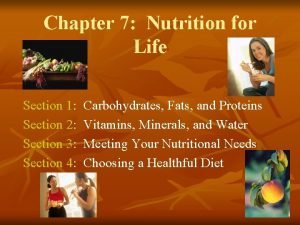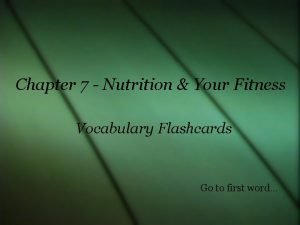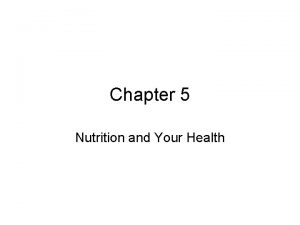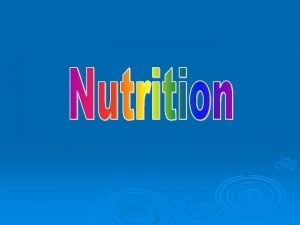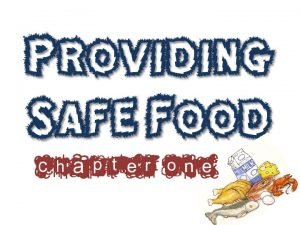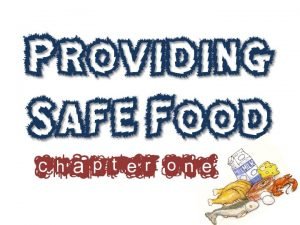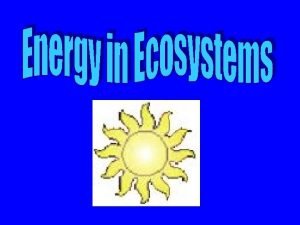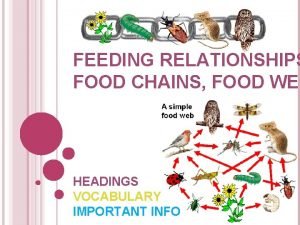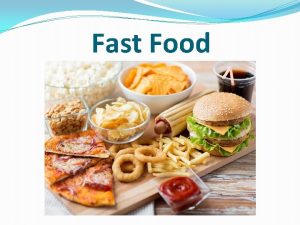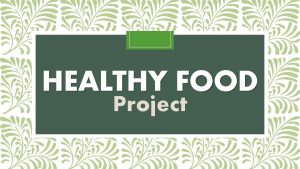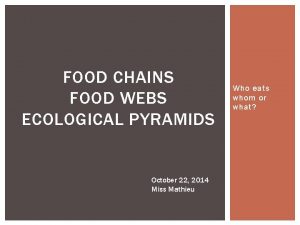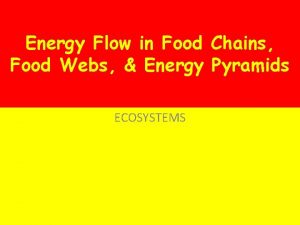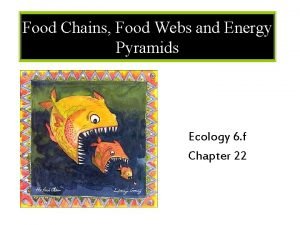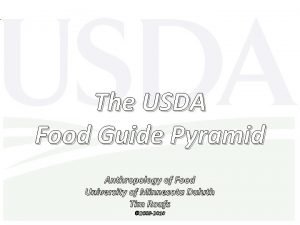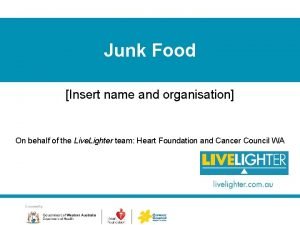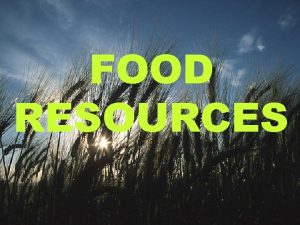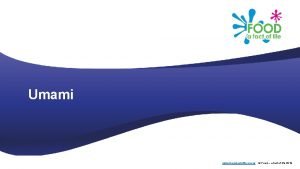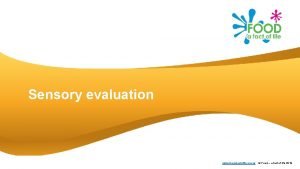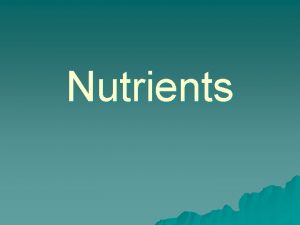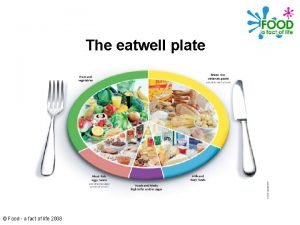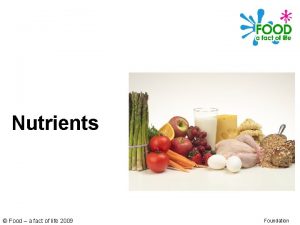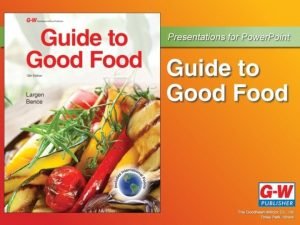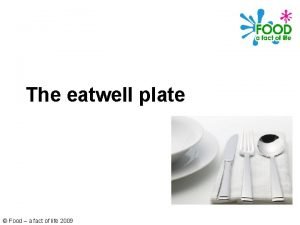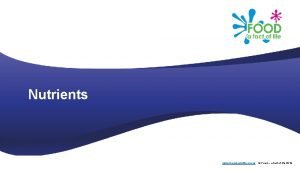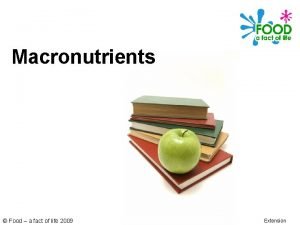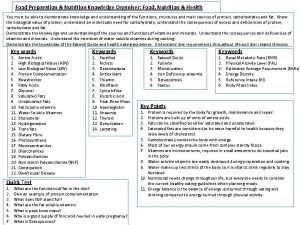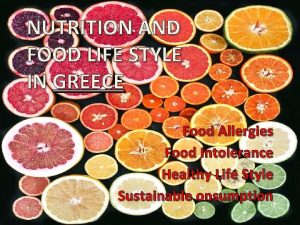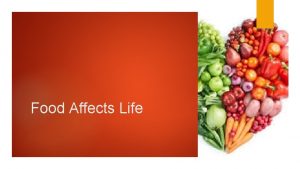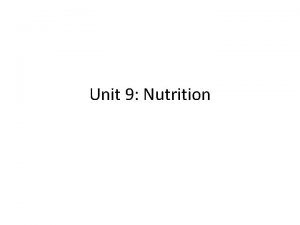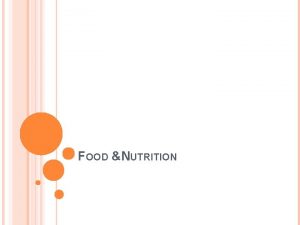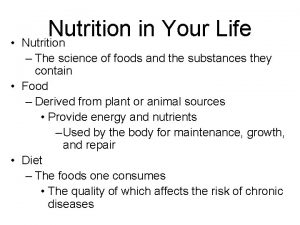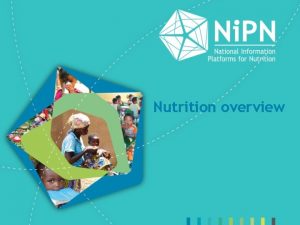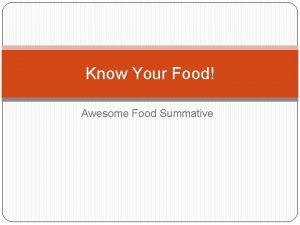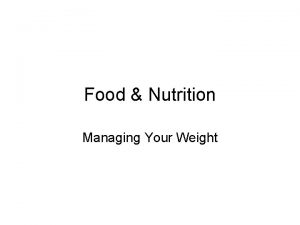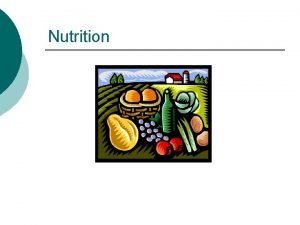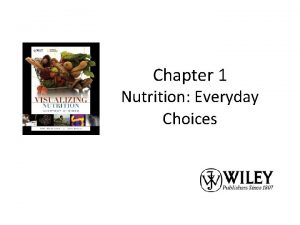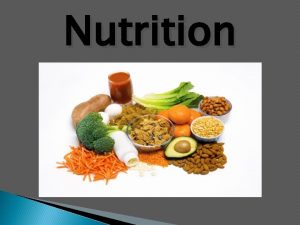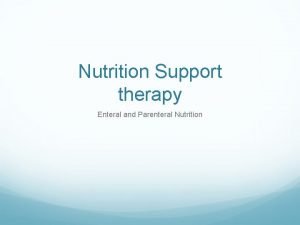Overview of Nutrition Nutrition in Your Life Food


















































































- Slides: 82

Overview of Nutrition

Nutrition in Your Life • Food – Derived from plant or animal sources • Provide energy and nutrients –Used by the body for maintenance, growth, and repair

Nutrition in Your Life • Diet – The foods one consumes • The quality of which affects the risk of chronic diseases

Food Choices • Personal preference • Habit • Ethnic heritage or tradition • Social interactions • Availability, convenience, economy

Food Choices • Positive and negative associations • Emotional comfort • Values • Body weight and image

Body Composition

The Nutrients • Inorganic nutrients – Minerals – Water

Planning A Healthy Diet

Diet Planning Principles • Adequacy • Balance • Kcalorie (energy) control

Diet Planning Principles • Nutrient density – Empty-kilocalorie foods • Moderation • Variety

A World Tour


The Nutrients • Organic nutrients – Carbohydrates – Lipids – Proteins – Vitamins

Carbohydrates (CH 2 O)n • Simple CHO • Monosaccharides – C 6 H 12 O 6 • Glucose • Fructose • Galactose

Disaccharides • Maltose • Sucrose • Lactose

Complex Carbohydrates • Polysaccharides – Glycogen – Starches – Fibers

Complex Carbohydrates • Fibers – Cellulose – Hemicelluloses – Pectins

Complex Carbohydrates • Fibers – Gums and mucilages – Lignin – Resistant starches

Complex Carbohydrates • Fibers – Soluble fibers • Viscous • Fermentable • Fibers – Insoluble fibers • Nonviscous • (Phytic acid)

Constancy of Blood Glucose • Diabetes – Type 1 diabetes » Failure of insulin production – Type 2 diabetes • Obesity • Hypoglycemia

Constancy of Blood Glucose • Glycemic response –Glycemic index

Accusations Against Sugars • Sugar causes obesity • Sugar causes heart disease • Sugar causes misbehavior in children and criminal behavior in adults • Sugar causes cravings and addictions – serotonin

Starch and Fiber • Health effects – Heart disease – Diabetes – GI health

Soluble Fibre • Lower blood cholesterol • Slow glucose absorption • Slow transit of food through upper GI tract • Holds moisture in stools, softening them • Yield small fat molecules that the colon can use for energy • Lower risk of heart disease • Lower risk of diabetes

Viscous Fibers

INSOLUBLE FIBRE • Insoluble and less fermentable • Cellulose • Lignins • Psyllium • Resistant starch • Many hemicelluloses

SOURCES • Sources – Brown rice, fruits, legumes, seeds, vegetables, wheat bran, whole grains – Extracted and used as food additives

INSOLUBLE FIBRE • Increase fecal weight • Speed fecal passage through colon • Provide bulk and feelings of fullness

Starch and Fiber • RDA for carbohydrate – 130 g/day – 45% - 65% total daily energy intake • Daily Value: 300 g/day • Fiber – Daily Value: 25 g/day – AI: 14 g/1000 kcal/day

The Lipids • Triglycerides • Phospholipids • Sterols

Fatty Acids and Triglycerides • glycerol + 3 fatty acids triglyceride + H 2 O


Sterols

Sterols • Roles of sterols – Bile acids – Sex hormones – Adrenal hormones – Vitamin D

Roles of Triglycerides • Fat stores – Energy – Protection – insulation

Essential Fatty Acids • Linoleic acid and the omega-6 family – Arachidonic acid • Linolenic acid and the omega-3 family – EPA =eicosapentaenoic acid – DHA = docosahexaenoic acid

Essential Fatty Acids


Health Effects of Lipids • Risks from trans fats • Risks from cholesterol • Benefits from monounsaturated fats and polyunsaturated fats

Recommended Intakes of Fat • DRI: 20% - 35% of energy intake • Linoleic acid AI – 5% - 10% of energy intake • Linolenic acid AI – 0. 6 - 1. 2% of energy intake

Guidelines to Groceries • Fat replacers Artificial fats Olestra



Protein: Amino Acids

Amino Acids • Nonessential amino acids – a. k. a dispensable amino acids • Essential amino acids – a. k. a indispensable amino acids • Conditionally essential amino acids

Roles of Proteins • Building material – Growth – Maintenance • Regulation of fluid balance – Edema • Acid-base regulation – Acidosis – Alkalosis

PROTEINS • Immunity – Antibodies – Antigens Source of energy

Hormones

Protein • RDA – 0. 8 g/kg/day – 10% - 35% of energy intake

Weight Management

The Psychology of Weight Cycling

Surgical Procedures

Weight-Loss Strategies • Eating plans – Be realistic about energy intake – Emphasize nutritional adequacy – Eat small portions – Lower energy density – Remember water – Focus on complex carbohydrates – Choose fats sensibly – Watch for empty kcalories

Weight-Loss Strategies • Physical activity – Activity and energy expenditure – Activity and metabolism – Activity and body composition – Activity and appetite control – Activity and psychological benefits – Choosing activities – Spot reducing

Weight-Loss Strategies • Behavior and attitude – Behavior modification – Become aware of behaviors – Change behaviors – Personal attitude – Support groups

Eating Disorders

Anorexia Nervosa

Bulimia Nervosa

Vitamins

Vitamin B 6 • Other names – Pyridoxine – Pyridoxal – Pyridoxamine • 1998 RDA – Adults (19 -50 years): 1. 3 mg/day • Upper level for adults: 100 mg/day

Vitamin B 6 • Chief functions in the body – Part of coenzymes PLP (pyridoxal phosphate) and PMP (pyridoxamine phosphate) used in amino acid and fatty acid metabolism – Helps to convert tryptophan to niacin and to serotonin – Helps to make red blood cells

Vitamin B 6 • Significant sources – Meats, fish, poultry – Potatoes, legumes, noncitrus fruits – Fortified cereals – Liver – Soy products • Deficiency symptoms – Scaly dermatitis – Anemia (small-cell type) – Depression, confusion, abnormal brain wave pattern, convulsions

Folate

Folate • Neural tube defects – Spina bifida • Heart disease • Cancer • Other names – Folic acid – Folacin – Pteroylglutamic acid (PGA) • 1998 RDA – Adults: 400 g/day • Upper level for adults: 1000 g/day

FOLATE • Deficiency symptoms – Anemia (large-cell type) – Smooth, red tongue – Mental confusion, weakness, fatigue, irritability, headache • Toxicity symptoms – Masks vitamin B 12 -deficiency symptoms

Vitamin B 12 • Deficiency of folate or B 12 produces pernicious anemia

• Other names: cobalamin (and related forms) • 1998 RDA – Adults: 2. 4 g/day • Chief functions in the body – Part of coenzymes methylcobalamin and deoxyadenosylcobalamin used in new cell synthesis – Helps to maintain nerve cells – Reforms folate coenzyme – Helps to break down some fatty acids and amino acids

Vitamin B 12: In Summary • Significant sources – Animal products (meat, fish, poultry, shellfish, milk, cheese, eggs) – Fortified cereals • Easily destroyed by microwave cooking • Deficiency disease: pernicious anemia

VITAMIN B 12 • Deficiency symptoms – Anemia (large-cell type) – Fatigue, degeneration of peripheral nerves progressing to paralysis • Toxicity symptoms: none reported

Vitamin C • Other name: ascorbic acid • 2000 RDA – Men: 90 mg/day – Women: 75 mg/day – Smokers: + 35 mg/day • Upper level for adults: 2000 mg/day

VITAMIN C • Significant sources – Citrus fruits – Cabbage-type vegetables, dark green vegetables (such as bell peppers and broccoli) – Cantaloupe, strawberries – Lettuce, tomatoes, potatoes – Papayas, mangoes • Easily destroyed by heat and oxygen

Vitamin And Mineral Supplements • Who needs supplements?

The Fat-Soluble Vitamins • A, D, E, and K

The Fat-Soluble Vitamins

Water And The Major Minerals

WATER

The Minerals An Overview

Calcium

• Significant sources –Milk and milk products –Small fish (with bones) –Tofu (bean curd), greens (broccoli, chard), legumes

Osteoporosis Healthy vs. Osteoporotic Trabecular Bones


 Unit 2 food food food
Unit 2 food food food Eltonian pyramid
Eltonian pyramid Food a fact of life explore food
Food a fact of life explore food Food a fact of life
Food a fact of life Change your water change your life
Change your water change your life Give us your hungry your tired your poor
Give us your hungry your tired your poor Digital illuminate aqa food preparation and nutrition
Digital illuminate aqa food preparation and nutrition Datingoo
Datingoo Food and nutrition unit 4
Food and nutrition unit 4 Section 38-1 food and nutrition answer key
Section 38-1 food and nutrition answer key Food and nutrition unit 5
Food and nutrition unit 5 38-1 food and nutrition
38-1 food and nutrition Extreme elite nutrition dog food
Extreme elite nutrition dog food Chapter 10 lesson 4 nutrition labels and food safety
Chapter 10 lesson 4 nutrition labels and food safety Chapter 10 lesson 4 nutrition labels and food safety
Chapter 10 lesson 4 nutrition labels and food safety Usda food and nutrition service
Usda food and nutrition service Food and nutrition unit 5
Food and nutrition unit 5 Factors to consider when choosing labour saving devices
Factors to consider when choosing labour saving devices Nutrition security meaning
Nutrition security meaning Section 38-1 food and nutrition
Section 38-1 food and nutrition Nutrition food
Nutrition food Nea2 food tech example
Nea2 food tech example Food n nutrition
Food n nutrition Food and nutrition grade 11
Food and nutrition grade 11 Food nutrition
Food nutrition Three sink method
Three sink method Chapter 8 food and nutrition
Chapter 8 food and nutrition Food buying guide for child nutrition programs
Food buying guide for child nutrition programs Food and nutrition expo
Food and nutrition expo Life science grade 11 animal nutrition
Life science grade 11 animal nutrition Nutrition across the lifespan
Nutrition across the lifespan Nutrition through life cycle
Nutrition through life cycle Chapter 7 nutrition for life
Chapter 7 nutrition for life Kelsey carbonetta
Kelsey carbonetta Fitness chapter 7
Fitness chapter 7 Chapter 5 nutrition and your health
Chapter 5 nutrition and your health Chapter 4 nutrition and your personal fitness
Chapter 4 nutrition and your personal fitness Seven fitness nutrition
Seven fitness nutrition Food scientists measure food energy in:
Food scientists measure food energy in: Which food is tcs food
Which food is tcs food Tcs food
Tcs food Food quantifiers exercise
Food quantifiers exercise Primary consumer secondary consumer tertiary consumer
Primary consumer secondary consumer tertiary consumer Food handlers can contaminate food when they answer
Food handlers can contaminate food when they answer Food product design from fast food nation summary
Food product design from fast food nation summary Lady bug food chain
Lady bug food chain Food chain and web
Food chain and web Food chain
Food chain Fast food can be defined as any food that contributes
Fast food can be defined as any food that contributes Food chain energy flow
Food chain energy flow Food web
Food web Food web and food chain
Food web and food chain Junk food vs healthy food project
Junk food vs healthy food project Food chains, food webs and ecological pyramids
Food chains, food webs and ecological pyramids Food webs and energy pyramids
Food webs and energy pyramids Food chains food webs and energy pyramid worksheet
Food chains food webs and energy pyramid worksheet How are food chains and food webs alike
How are food chains and food webs alike How many food chains are there in the food web
How many food chains are there in the food web Role play on healthy food and junk food
Role play on healthy food and junk food Introduction of role play
Introduction of role play Junk milk
Junk milk Desert food chains
Desert food chains Food pyramid
Food pyramid Junk food
Junk food Control measures for physical hazards
Control measures for physical hazards Changes caused by agriculture and overgrazing
Changes caused by agriculture and overgrazing Conclusion of healthy food and junk food
Conclusion of healthy food and junk food Food handlers can contaminate food when they
Food handlers can contaminate food when they Which is a tcs food bread flour sprouts strawberries
Which is a tcs food bread flour sprouts strawberries Good food good life
Good food good life Food a fact of life costing
Food a fact of life costing Food a fact of life
Food a fact of life Food a fact of life
Food a fact of life Food fact of life sensory evaluation
Food fact of life sensory evaluation Nutrients are life-sustaining substances in food
Nutrients are life-sustaining substances in food Eatwell plate
Eatwell plate Food a fact of life
Food a fact of life What is enrobing in cooking
What is enrobing in cooking Chapter 1 food affects life
Chapter 1 food affects life Chapter 1 food affects life
Chapter 1 food affects life Food a fact of life
Food a fact of life Food a fact of life
Food a fact of life Food a fact of life
Food a fact of life


